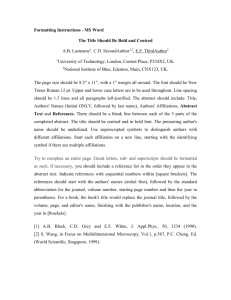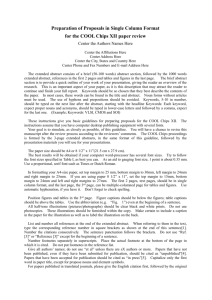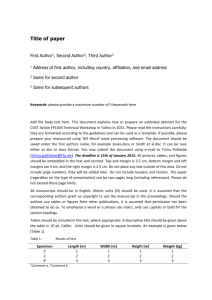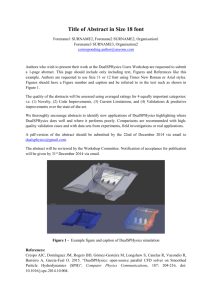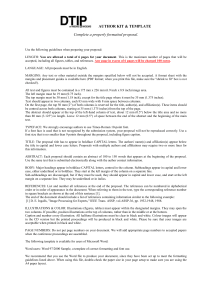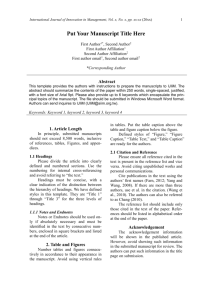TITLE OF THE CONTRIBUTION
advertisement
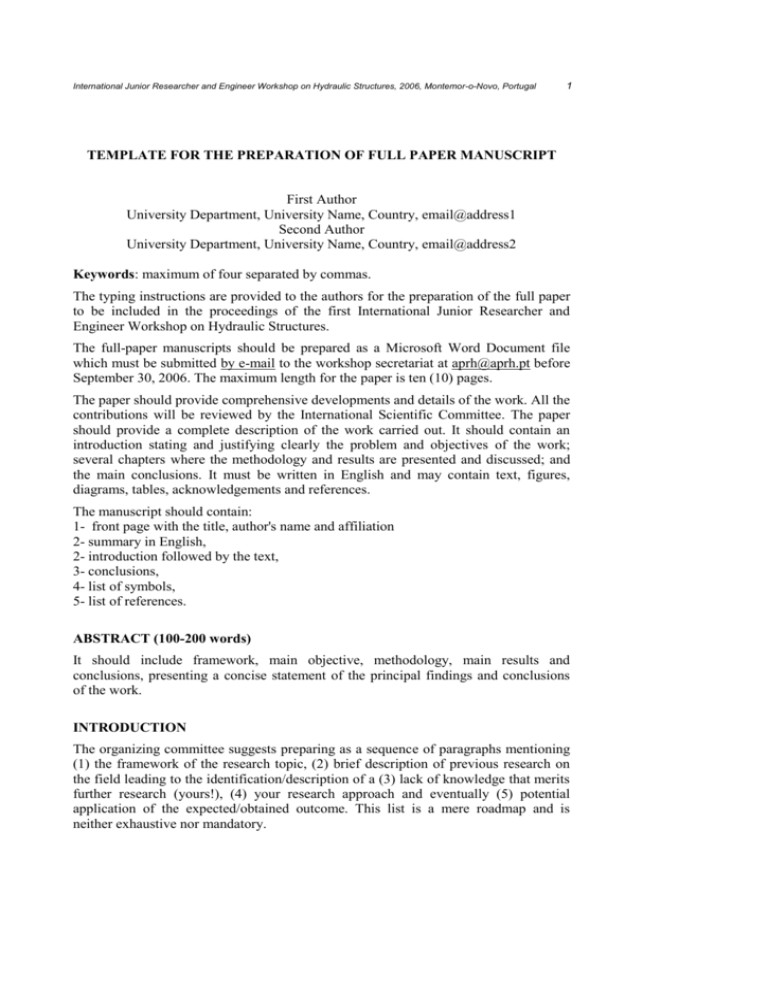
International Junior Researcher and Engineer Workshop on Hydraulic Structures, 2006, Montemor-o-Novo, Portugal 1 TEMPLATE FOR THE PREPARATION OF FULL PAPER MANUSCRIPT First Author University Department, University Name, Country, email@address1 Second Author University Department, University Name, Country, email@address2 Keywords: maximum of four separated by commas. The typing instructions are provided to the authors for the preparation of the full paper to be included in the proceedings of the first International Junior Researcher and Engineer Workshop on Hydraulic Structures. The full-paper manuscripts should be prepared as a Microsoft Word Document file which must be submitted by e-mail to the workshop secretariat at aprh@aprh.pt before September 30, 2006. The maximum length for the paper is ten (10) pages. The paper should provide comprehensive developments and details of the work. All the contributions will be reviewed by the International Scientific Committee. The paper should provide a complete description of the work carried out. It should contain an introduction stating and justifying clearly the problem and objectives of the work; several chapters where the methodology and results are presented and discussed; and the main conclusions. It must be written in English and may contain text, figures, diagrams, tables, acknowledgements and references. The manuscript should contain: 1- front page with the title, author's name and affiliation 2- summary in English, 2- introduction followed by the text, 3- conclusions, 4- list of symbols, 5- list of references. ABSTRACT (100-200 words) It should include framework, main objective, methodology, main results and conclusions, presenting a concise statement of the principal findings and conclusions of the work. INTRODUCTION The organizing committee suggests preparing as a sequence of paragraphs mentioning (1) the framework of the research topic, (2) brief description of previous research on the field leading to the identification/description of a (3) lack of knowledge that merits further research (yours!), (4) your research approach and eventually (5) potential application of the expected/obtained outcome. This list is a mere roadmap and is neither exhaustive nor mandatory. International Junior Researcher and Engineer Workshop on Hydraulic Structures, 2006, Montemor-o-Novo, Portugal 2 Figure 1 – View of Guadiana river downstream of Alqueva dam. PAGE AND TEXT SET-UP The proceeding with be published in B5 format but edition should be done in A4 format. Please follow carefully the instructions: 1. Top margin: 44 mm; 2. Bottom margin: 48 mm; 3. Left margin: 20 mm; 4. Right margin: 54 mm; 5. Header margin: 24 mm; 6. Footer margin: 28 mm; 7. Text must be “justified” and single-spaced 8. The font size must be 11 points. 9. The recommended font type is Times or TimesNewRoman. 10. Footnotes should be typed at the bottom of the page to which they apply, and should be separated by a line extending across the page. 11. Figures and tables must be centred and within the limits of the page. 12. Please do not write anything in the header and the footer. 13. No indentation should be made in the first line of a paragraph. 14. Between paragraphs an interval of one line interline shall be given. 15. Do not use subsubsections. 16. Section titles should have a 6 point before/after margin. 17. Heading 2 style should be Low case + bold, as in “Instrumentation”. Type the title of the manuscript in bold capitals using Times New Roman 12 pt. International Junior Researcher and Engineer Workshop on Hydraulic Structures, 2006, Montemor-o-Novo, Portugal 3 typeface. All lines of the title should be centred similar to the title of these instructions. After the last line of the Title, skip two lines and type the name(s) and affiliation(s) of the author(s) centred, as shown. After the name(s) of author(s), skip two lines for beginning with the abstract. FIGURES AND TABLES Figures and Tables should appear in the text near to where they are first referenced. They should be centred between the margins, and must not fall outside of the normal printed area of the page which is 136 mm wide by 205 mm high. The font size for all numbers and letters in the figure, as it appears in your paper, must be at least 2 mm. Put table captions above the table, and figure captions below the figure. Both captions must be centered. Refer to figures and tables as in “Figure 1, Table 1”. Table and Figure text and caption must have font size 9. Leave a blank line between the table/illustration caption and the adjacent text. Table 1 – Cost of an espresso coffee. Country France Portugal Switzerland Cost (€) 1.00 0.65 2.50 Illustrations shall be pasted into the body of the text. Leave a blank line between the upper boundary of the figure and the text. At the bottom of the figure type the caption of the figure centred as shown. After the caption leave a blank line before continuing with the text. It is the author’s responsibility to obtain a written permission from the original publisher of any borrowed illustration when this applies. Only black and white (with shades of gray) illustrations will be reproduced. The authors should pay attention not to use the colour to distinguish between the different types of lines in a figure. The figures should be referred to as Figure #. For photos or any other manipulated image, please use image editing software to save each figure as an individual file with dimensions similar to those in the paper. This avoids saving unnecessarily large .DOC files. EQUATIONS Mathematical formula must be typewritten. The symbols must be listed by alphabetical order in the references section. Internationally accepted symbols must be used. The authors should use the International System of Units (SI). Use Microsoft Equation Editor or equivalent to write your equations. (Do not use Microsoft Field Codes.) These should appear left aligned and sequentially numbered starting from 1, such as: International Junior Researcher and Engineer Workshop on Hydraulic Structures, 2006, Montemor-o-Novo, Portugal Fr U 4 (1) gh Do not leave blank lines before and after equations. The equation numbers should be written in parenthesis and must be located 13 cm from the left margin to be close to the right margin as shown above. Equations should be referred to as Equation (1). For simple equations in the text always use superscript and subscript (select Font in the Format menu). Do not use the Equation Editor between text on the same line. MISCELLANEOUS POINTS Try to avoid isolated lines of text where, for example, a paragraph spills over a page. Often a slight rewording resolves the problem. Avoid wasted white space around figures or a last page that is almost empty. Use quotation marks correctly, as in "correct". Use a hyphen (-) for compound words (two-dimensional), to link numbers, nouns or names (Navier-Stokes, pages 27-85). Names after family names should start with a capital: e.g., Pascal (or Pa) after Blaise PASCAL. Resist the temptation to use footnotes. The revision will take into account the manuscript’s format. If necessary, some minor editing corrections will be done by the conference secretariat. If this effort justifies, the authors may be invited to resubmit a revised version of their abstract. ACKNOWLEDGMENTS Any acknowledgments should appear immediately before the references. They may be written in 10 points. REFERENCES References should include the author's name and initials, year of publication, full title, journal or publishing company (for books), place of publications, volume number, pages numbers. The ASCE requirements for references provide some good examples: Liggett, J.A. (1993). "Critical Depth, Velocity Profiles and Averaging." Jl of Irrig. and Drain. Engrg., ASCE, Vol. 119, No. 2, pp. 416-422. Liggett, J.A. (1994). "Fluid Mechanics." McGraw-Hill, New York, USA. The references may be written in 10 points with a 0.5 cm left-hanging. In the text, quotes, citations and references should be written as: "Liggett (1993) showed ...", "the flow rate per unit width is maximum at critical flow (Liggett 1993)". When a reference has one or two authors, the name of the author(s) must be stated in the text: Liggett (1993), Muste and Ettema (2005). If there are more than 2 authors, the proper reference should be: (Rodi et al. 1985).
